Editorial

Welcome to 2007! The news here in the Wide Brown Land is that El Nino has peaked and rainfall should return to normal—whatever that is—by March. Maybe. We hope. Brisbane has had the coldest Christmas for 100 years, with occasional drizzle. It even snowed in parts of the country that would usually expect 100°F+ days at this time of year. Regardless, the water restrictions are not going to go away anywhere in the country. The State of Victoria has even gone so far as to create a new form of "Water Police" with unusual Powers Of Entry and the ability to have the water flow to the properties of repeat offenders reduced to a trickle. Framers are shooting their stock, unable to feed them and a good piece of beef is getting hard to find. Sometimes seems like the days of Soylent Green can't be that far away.
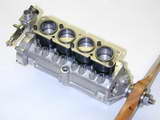 My resolution for 2007 is No More Resolutions! What gets made, gets made. What doesn't, doesn't. But the Cirrus will get finished because that @!#%%* broken tap is out and final assembly is well underway. Expect to read the fiddlin' and fettlin' saga next month—working title: Trouble with Trimble. We've got a lot of words and pictures this month that describe the lead-up to the five minute tap removal process in complete and boring detail, making it a cross between a How-to tip and a Model Engineering Project, so it's indexed under both. Then we take two close looks at the most unconventional model engine ever to enter commercial production. There's new entries in the Gallery and Watzit? pages, plus some news items and a new navigation tool which will help you (and me!) discover all the rubbish that's accumulated here over the past eight years. All for free (I must be totally insane).
My resolution for 2007 is No More Resolutions! What gets made, gets made. What doesn't, doesn't. But the Cirrus will get finished because that @!#%%* broken tap is out and final assembly is well underway. Expect to read the fiddlin' and fettlin' saga next month—working title: Trouble with Trimble. We've got a lot of words and pictures this month that describe the lead-up to the five minute tap removal process in complete and boring detail, making it a cross between a How-to tip and a Model Engineering Project, so it's indexed under both. Then we take two close looks at the most unconventional model engine ever to enter commercial production. There's new entries in the Gallery and Watzit? pages, plus some news items and a new navigation tool which will help you (and me!) discover all the rubbish that's accumulated here over the past eight years. All for free (I must be totally insane).
Unique visitors to the web site during the month of December 2006 rose again to a new peak of over 12,000. Hits totaled 1.17 million and consumed over 12 GB of download bandwidth. Looks like I'll have to get the quotas upped again soon. All in all, looks like 2007 will be a big year. So, on behalf of the hard working staff at Model Engine News (dot org) and The Motor Boys, I'd like to wish everyone, everywhere, a happy and prosperous 2007 (just ignore all my dry land ranting; I'll get over it...)
Site Map
With more than 550 separate pages, just remembering what is on this site has become a nightmare. I've been pondering this problem for a while. The Site Search Facility was the first stage solution. It will find a page containing a word, words, or phrase, but you and I need to know what the word is first. To make the search results meaningful, each page has a hidden but relatively accurate title. This leads to the Stage II solution (ta-da  ):
):
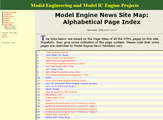 The left-hand navigation bar contains a new menu class called Site Map. It contains links to two index pages which are generated automatically each month when the site is updated. The first is called the Alpha Index. It has a set of links to all the site content pages, listed alphabetically by page title. "Housekeeping" pages are omitted, and some pages will be accessible by Model Engine News Members only, but using this index, you could browse the entire site. Theory says this may result in better indexing by some external search engines too.
The left-hand navigation bar contains a new menu class called Site Map. It contains links to two index pages which are generated automatically each month when the site is updated. The first is called the Alpha Index. It has a set of links to all the site content pages, listed alphabetically by page title. "Housekeeping" pages are omitted, and some pages will be accessible by Model Engine News Members only, but using this index, you could browse the entire site. Theory says this may result in better indexing by some external search engines too.
The other list, called the Update Index, contains (surprise, surprise) only those pages which have been added, or have changed during the past month. The number of links on this page is abnormally large this month as I've had to revise a lot of page titles after having my nose rubbed in how useless some of them were. Updates may be just changes to the page title, revisions to the text, or (ahem) spelling corrections. Sorry there's no way to indicate what the change is (yet).
This rather duplicates the new feature added to the Engine Finder last month, which I may drop since maintaining it is a manual rather than automated process. Depends on how painful it becomes. Incidentally, the Engine Finder has a number of entries that link to isolated engine pictures which are not linked to any text page, so the site map does not index absolutely everything. I'll fix this gradually. In the mean time, I've had fun just browsing casually, rediscovering stuff I'd forgotten that I'd written. Comments on how useful or otherwise you find things like this are always welcome.
Doing Time
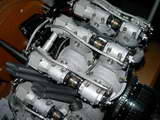
Brian Perkins sent an email last month that made me laugh out loud. His magnificent Bristol Hydra is in the final assembly stage and it's taken so long he likens it to a prison term! The latest photos accompanying Brian's email have been added to The Engine Gallery, where you'll also find a link to the Twisty Little Maze of links to previous highlights from his sentence, with hard labor. Everything about this engine is magnificent. Just look at the Oldham couplings between the camshaft segments of the in-line cylinders.
GP II Revisited

Following last month's Engine of the Month review, I've had a most delightful email exchange with Luis Petersen—the man who actually made the engine in question. Luis has sent a mountain of material and corrected a number of points on the original GP II page, which has been completely revised. Many of the points are small, but all are significant. Best of all to me as an engine builder is the photograph of the tooling used to machine the piston. I will always be in awe of this craftsmanship. Click on the thumbnail to read about the tooling, and while you are there, re-read the whole page.
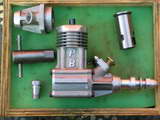 Luis had stayed with Paul Bugl for a month in 1976, assisting with engine manufacture. On returning to his home in Denmark, he was trusted by Bugl with all PB engine repair work. The Bugl page draws on a number of references appearing in attributed articles published in the old Model Engine World. Luis wrote to the MEW editor, John Goodall to correct some points and dispel some rumors, but by that time Goodall had ceased publication so the corrections never made it to print. Model Engine News is therefore pleased to be able to publish Luis' letter and perhaps help set the record straight. Click here for the text. Luis also has the only front rotary Bugl 15 diesel in existence. Visit Page 9 of the Engine Gallery for pictures and more details.
Luis had stayed with Paul Bugl for a month in 1976, assisting with engine manufacture. On returning to his home in Denmark, he was trusted by Bugl with all PB engine repair work. The Bugl page draws on a number of references appearing in attributed articles published in the old Model Engine World. Luis wrote to the MEW editor, John Goodall to correct some points and dispel some rumors, but by that time Goodall had ceased publication so the corrections never made it to print. Model Engine News is therefore pleased to be able to publish Luis' letter and perhaps help set the record straight. Click here for the text. Luis also has the only front rotary Bugl 15 diesel in existence. Visit Page 9 of the Engine Gallery for pictures and more details.
Another Variation on some Old Themes
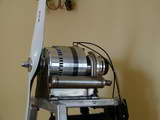
I'd like to tell you what's inside the case of this unusual engine, but I'm sworn to secrecy! The engine is the brain-child of talented Canadian engineer, Michel Arseneau. Michel is a very talented man. Click the picture to visit Page 9 of the gallery where you can view more pictures of Michel's unique engine, plus a number of his more conventional—in comparison—model engines, like a trio of two stroke radials and an in-line piston Aero 35 replica from bar-stock!
Hemingway Plans and Problems
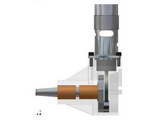
Last month we mentioned that Hemingway has bought out Woking Precision Models. This has now been confirmed by Kirk Burwell of Hemingway. Since taking over Hemingway a few years back, Kirk has been revitalizing the range with new kits and fully re-drawn plans incorporating 3D models. They also have an increased web presence to make life easier for international customers. The old ETW and Sparey designs previously sold by Woking will get the same treatment. First cab off the rank is the Sparey 5cc diesel, aka the Aeromodeller Diesel. The picture here shows progress being made on the revised drawings for the Sparey 5.
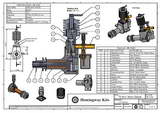 This will be followed by the small Sparey with information enabling it to be built as a 0.63cc engine (as designed, drawn, and published), a 0.8cc engine (as it was incorrectly labeled), and a 1cc engine (the Millennium Edition as developed by me). Woking's Sparey cases have been sand cast and I've heard them described as vaguely crankcase shaped pieces of aluminum, although with a bit of work, they clean up nicely. This too will be under consideration for upgrade. Kirk is considering changes to the range of ETW castings offered too. If you've got a favorite, email Kirk at Hemingway and let him know (Kinglet, Kirk, Kinglet!!!
This will be followed by the small Sparey with information enabling it to be built as a 0.63cc engine (as designed, drawn, and published), a 0.8cc engine (as it was incorrectly labeled), and a 1cc engine (the Millennium Edition as developed by me). Woking's Sparey cases have been sand cast and I've heard them described as vaguely crankcase shaped pieces of aluminum, although with a bit of work, they clean up nicely. This too will be under consideration for upgrade. Kirk is considering changes to the range of ETW castings offered too. If you've got a favorite, email Kirk at Hemingway and let him know (Kinglet, Kirk, Kinglet!!!  )
)
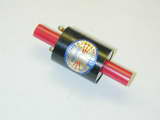 But there's a fly in the ointment. Modelectric, the company which made the coils Woking used and supplied for all the ETW four-cycle spark ignition engines, are no longer able to supply. ETW did not design for glow ignition and such a change would require an increase in the Compression Ratio. Besides, a lot of the charm in the engines is the spark ignition. Kirk would welcome approaches from any company willing to step into the gap with coil supply.
But there's a fly in the ointment. Modelectric, the company which made the coils Woking used and supplied for all the ETW four-cycle spark ignition engines, are no longer able to supply. ETW did not design for glow ignition and such a change would require an increase in the Compression Ratio. Besides, a lot of the charm in the engines is the spark ignition. Kirk would welcome approaches from any company willing to step into the gap with coil supply.
Another Mancini
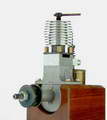
After years of no Mancini M20 pictures at all, suddenly we've got two of them (Mancinis? Mancinii?). Following hard on the heels of Roger Schroeder's Mancini M20 that appeared last month, Roger mailed in some photos of another engine made by Giacomo Mauro, none other than one the three Italian gentlemen who produced the die-cast case. The other two were Benito Dusi, and Amato Prati. Their effort was serialized in the Italian language magazine, Modellistica in 1997. The design harks back to Italy in 1943, appearing in the August issue of L'Aquilone. It was republished, translated into German, in Der Sportfleiger of February 1944, then into French for Le Modele Reduit D'Avion of May 1944. The French publication acknowledged the German one which in turn, credited Mr E (Emilio) Mancini of Varese, so provenance is preserved and life is good—although you may recall life in Europe was a bit hectic at the time, making this all the more amazing. Sample pages of my CAD rendering of the engine can be viewed here on the Motor Boys Model Engine Plans Book page, and you can still buy copies of our book from the AMA (I believe it's now only $19.95, by the way).
Grubs, Maggots, and Screws
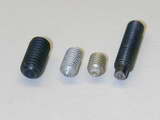
Machinery's Handbook is touted as "The Bible of the Metalworking Industry" by Industrial Press, its American publishers, currently celebrating their 90th year of publication. My 25th edition (1995) devotes several pages to Set Screw specifications, but nowhere does it define what a "set screw" actually is. The closest it comes is when specifying the Holding Power of Set-screws from which we deduce that a set-screw is threaded into one part to contact another and thus transfer power or torque from one to the other, hopefully without slipping if you've done your sums right. As such, it is the design of the contact end of the screw that is important and the variety here is considerable. The photo shows four different styles I found in my spares collection representing, left to right, cup-point, cone-point, ANSI type C, and dog-point. There are others.
Many believe that "set screw" implies a headless screw. Machinery's handbook provides specifications for a wide variety of Headless Set Screws, implying that not all set screws are headless. In fact, there are a couple of pages providing dimensions and specifications for ANSI (American National Standards Institute) and BS (British Standard) square head set-screws where the head is most certainly larger than the screw diameter.
Where am I going with this? Well, it has to do with readability. I'm quite conscious that while the readership of these pages is International, almost 70% of hits originate in the USA. So I should orient my writing towards that culture, and to an extent, I do; spelling "center" with an er rather than an re as my cultural baggage would demand. But as an Australian, a degree of Larrikinism is mandatory, so I'll use terms that I think are the most descriptive over what I know to be the most common in the USA.
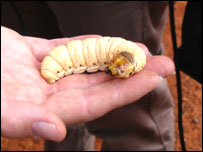 And for that reason, when I want to describe a headless screw, I'll call it a Grub Screw knowing that the Brits, Ozzies, and Kiwis will know instinctively what it is, while an American reader may be confused for a second or two before figuring it out—a headless critter that lives in a hole. Better add Germans to that list. I just received a mail from a reader there with the brilliant trivia factoid that the German word for the headless set screw is Maddenschraube; literally, "maggot-screw". Ok, I can accept that, but there are limits and I'll stick with Grub. The little one heading this paragraph is an Australian witchetty grub, viewed as bush tucker by Australian Aborigines, but not certain Princes Royal. For once, I completely agree with Him!
And for that reason, when I want to describe a headless screw, I'll call it a Grub Screw knowing that the Brits, Ozzies, and Kiwis will know instinctively what it is, while an American reader may be confused for a second or two before figuring it out—a headless critter that lives in a hole. Better add Germans to that list. I just received a mail from a reader there with the brilliant trivia factoid that the German word for the headless set screw is Maddenschraube; literally, "maggot-screw". Ok, I can accept that, but there are limits and I'll stick with Grub. The little one heading this paragraph is an Australian witchetty grub, viewed as bush tucker by Australian Aborigines, but not certain Princes Royal. For once, I completely agree with Him!
New Books and Magazines This Month
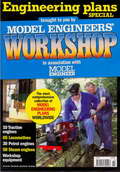
Even though the cost is staggering due to the highly unfavourable exchange rate between Australia and the United Kingdom, I still maintain a regular subscription to the Model Engineer's Workshop because to me, it's worth it. Last month, subscribers received a "Plans Special" edition. Although it's not clear if this is a gratis bonus, or part of the annual subscription, it is worth comment for a couple of reasons. The plans listed arise for the most part from construction features in MEW and sister magazine, the Model Engineer, plus a surprising number from dead relatives like the Aeromodeller, Model Maker, and even The Model Mechanic. The plans are listed under eight categories:
- Traction Engines
- Locomotives
- LBSC Locomotives
- Miscellaneous and Stationary Engines
- IC Engines
- Workshop Equipment
- Clocks
- Classic Racing and Sports-Racing Cars
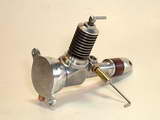 The reason I'm giving this relatively obscure publication so much attention is, as you have probably guessed by now, category 5: IC Engines. This section lists
42 engines, plus a magneto. We have the usual suspects like Eric Whittle's aero V8, Lew Blackmore's Bentley BR2 rotary and a gaggle of Westbury's designs. The surprise is the revival of designs that have not been included in their plans lists for several years. These include the Topsy, the Weaver-Ransom (errors and all, I'll bet), and several others. I'm guessing that this indicates a growing awareness within the editorial staff of the increased interest and demand for model internal combustion engines plans. If so, this confirms what I've observed for the past ten years or so. I would not be surprised if our friend Nemett, designer of the NE15S four-stroke recently serialized in the Model Engineer, has not had an influence on this revival of archival plans too.
The reason I'm giving this relatively obscure publication so much attention is, as you have probably guessed by now, category 5: IC Engines. This section lists
42 engines, plus a magneto. We have the usual suspects like Eric Whittle's aero V8, Lew Blackmore's Bentley BR2 rotary and a gaggle of Westbury's designs. The surprise is the revival of designs that have not been included in their plans lists for several years. These include the Topsy, the Weaver-Ransom (errors and all, I'll bet), and several others. I'm guessing that this indicates a growing awareness within the editorial staff of the increased interest and demand for model internal combustion engines plans. If so, this confirms what I've observed for the past ten years or so. I would not be surprised if our friend Nemett, designer of the NE15S four-stroke recently serialized in the Model Engineer, has not had an influence on this revival of archival plans too.
The plans in question have passed through at least five copyright owners to my knowledge. Many of them would date back to the India ink on linen days and all of us who love making models should be grateful to the successive owners who have stored hundreds and hundreds of masters, flat, in bulky metal cabinets for more than half a century against the occasional sale. I'll bet years, decades even, went by when some of them were not reproduced at all. I believe an effort was mounted to digitize them not long ago. But even if so, they had to be preserved long enough for technology to make this possible. We are talking investment and it is not unreasonable to expect a return on that investment. The Plans Special lists the plans, interspersed with advertisements from companies able to supply castings and related materials for the designs. This makes good business sense for everyone, even us consumers.
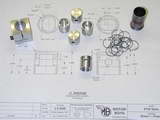
One of the plans listed is ETW's Seal. By pure coincidence, this engine is the focus of a group of volunteer craftsmen under the Joe Martin Internet Craftsmanship Museum banner who are building an engine for display and the enjoyment of those who would like to build one, or just see one built. The results will be made available to everyone through the Museum web site (that's my contribution in the photo: pistons and rings). Museum people approached Model Engineer management for permission to make all or part of the original text available to compliment the on-line display. This permission was refused, with a reminder of the
60 year UK copyright period on the material. Would ME plan sales and their advertisers' sales increase or decrease had permission been given? Hard, or more like impossible to say. Given the circumstances and follow-on risk due to precedent, ME probably had no real choice in this decision, although they could have been a bit more tactful about it. Regardless, they and their predecessors must be praised for preserving the plans, and if you want a Topsy, you now know where it can be bought (price about AU$25 plus postage; ouch).
Engine Of The Month: Aero 35
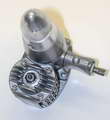
The horizontal piston Aero 35 must have had more column-inches written about it in the model press than any other engine. The Giant Engine Review Index lists four reviews, omitting Wild Bill Netzeband's American Modeler review from the Sep/Oct '63 issue which spends a page describing the mechanism used, but does not even state the displacement. Ron Warring reviewed it, Stu Richmond reviewed it, David Janson reviewed it, Peter Chinn reviewed it three times, and it's appeared more than once or five in the Engine Collectors' Journal as well. So why should I be the odd man out? Visit the new Aero 35 page, and have a look at the David Janson review for another opinion.
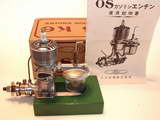
At the other end of the scale, a reader emailed to ask where the Chinn OS K6 review was? Never written, as far as I know, was my answer. But David Janson's Model Engine Designer and Manufacturer Profiles has one, so the OS type 6 (K6) reproduction review has been added to the scanned Janson reviews. If anyone wants to see some engine from the Janson Index added, drop me a mail and I'll consider it.
Needles and Pins
Dave Owen has sent in the story of how Gordon Burford solved the needle problem for his engines before his shop gained the capability to manufacture them economically. The tale has been pinned to the end of the Gee Bee 5cc page perhaps making it a tail. The page itself has got a face-lift and some additional cross-linking.
Vintage Glow?
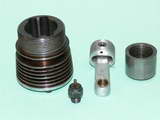
Dave Owen also supplied a Watzit to welcome in the new year. Luckily, it came complete with the answer as it would have stumped me completely, along with 99% of the rest of the world, I think. The engine is one of only three known to still exist from a total production of maybe 20 engines. So click this link to Watzit #71 (there are only a total of 31 Watzits in the Watzit Index. For some reason I started numbering backwards from 99). The entry mentions a book by Czech modeller, Jiri Linka. Don't confuse this with the books Modelarske Motory volumes (1) and (2) by the better known Czech modeler, Jiri Kalina. David reports that the Linka book contains excellent photographs of probably the majority of engines made in the former Czechoslovakia during the Cold War years and as such, is a wonderful record of small-scale production under what must have been arduous (to us) conditions.
I've not seen the book, so I can't really comment except to say I trust Dave's judgment. He says copies are available at US$25 + $10 postage world-wide and that Jiri now accepts Paypal. Jiri's email is model (dot) engines (at) quick (dot) cz and pardon the anti- email address snarfing obfuscation.
Tech Tip of the Month: Removing Broken Taps
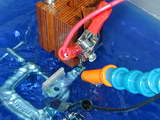
This How-to lists all the ways I can think of to remove the dreaded broken tap, then concentrates on the one, sure-fire way—even if it is probably the most expensive! The book review in last month's issue was The EDM How-To Book. At that time, work on the EDM electronics had been completed and the ram mostly built. All work is now complete and the device has removed the broken 4-40 tap from the Cirrus crankcase with no damage to the thread. I truly believe that this was the only practical solution open in this case, although there were others. I can now give both book and EDM a full positive endorsement. Follow the Model Engineering | EDM link to the pages and decide for you self.
 Site Map
Site Map
 Doing Time
Doing Time
 GP II Revisited
GP II Revisited
 Another Variation on some Old Themes
Another Variation on some Old Themes
 Hemingway Plans and Problems
Hemingway Plans and Problems
 Another Mancini
Another Mancini
 Grubs, Maggots, and Screws
Grubs, Maggots, and Screws
 Needles and Pins
Needles and Pins
 Vintage Glow?
Vintage Glow?
 Editorial
Editorial
 New Books and Magazines This Month
New Books and Magazines This Month
 Engine Of The Month: Aero 35
Engine Of The Month: Aero 35
 Tech Tip of the Month: Removing Broken Taps
Tech Tip of the Month: Removing Broken Taps
 Standard Stuff
Standard Stuff


 ):
):







 )
)



 And for that reason, when I want to describe a headless screw, I'll call it a Grub Screw knowing that the Brits, Ozzies, and Kiwis will know instinctively what it is, while an American reader may be confused for a second or two before figuring it out—a headless critter that lives in a hole. Better add Germans to that list. I just received a mail from a reader there with the brilliant trivia factoid that the German word for the headless set screw is Maddenschraube; literally, "maggot-screw". Ok, I can accept that, but there are limits and I'll stick with Grub. The little one heading this paragraph is an Australian witchetty grub, viewed as bush tucker by Australian Aborigines, but not
And for that reason, when I want to describe a headless screw, I'll call it a Grub Screw knowing that the Brits, Ozzies, and Kiwis will know instinctively what it is, while an American reader may be confused for a second or two before figuring it out—a headless critter that lives in a hole. Better add Germans to that list. I just received a mail from a reader there with the brilliant trivia factoid that the German word for the headless set screw is Maddenschraube; literally, "maggot-screw". Ok, I can accept that, but there are limits and I'll stick with Grub. The little one heading this paragraph is an Australian witchetty grub, viewed as bush tucker by Australian Aborigines, but not 





